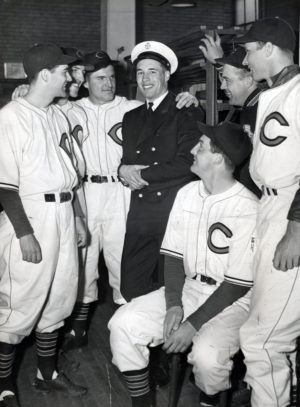
In 1939, 1940 and 1941, Bob Feller became the best pitcher in all of baseball, leading the American League in wins, innings pitched and strikeouts each season. But he was most proud of his service in the U.S. Navy during World War II. He was decorated with five campaign ribbons and eight battle stars. He is the only Chief Petty Officer in the Baseball Hall of Fame.
By Don Doxsie
Bob Feller was just about to exit the state of Iowa when he heard the news. The star pitcher for the Cleveland Indians was on the road in his new Buick Century, driving from his home in Van Meter to Chicago to discuss his contract for the 1942 season and he was just about to cross the bridge over the Mississippi River into Illinois. That’s when he heard it on the car radio: Japanese war planes had launched a full-scale attack on Pearl Harbor, killing thousands and inflicting severe damage on U.S. naval forces stationed there. It was Dec. 7, 1941. The United States was at war.
Feller recalled many years later in a column he wrote for Military.com exactly what he felt as he drove the rest of the way to Chicago.
“I was,’’ he remembered, “mad as hell.’’
When he arrived in Chicago and sat down to chat with Cy Slapnicka, the Iowa scout who first signed him and who had risen to become general manager of the Indians, the conversation had nothing to do with money. Feller told Slapnicka that he planned to enlist in the U.S. Navy and help defend his country. He called former heavyweight boxing champion Gene Tunney, who was a commander in charge of the Navy’s physical training program. Two days later in Chicago, Tunney swore in Feller.
He was the first major sports celebrity to enlist. In the weeks and months that followed, others followed his lead, including some of baseball’s brightest stars. Joe DiMaggio. Ted Williams. Hank Greenberg. Stan Musial.
A total of 4,500 professional ballplayers ended up serving in World War II. But Feller led the way. As veteran sportswriter Bob Hertzel wrote in 2010 at the time of Feller’s death, “Feller made it the American thing to do, to give up life as a professional athlete to serve in the military effort against Germany and Japan.’’
TO READ MORE ABOUT THIS STORY AND OTHER FASCINATING STORIES ABOUT IOWA HISTORY, subscribe to Iowa History Journal. You can also purchase back issues at the store.
